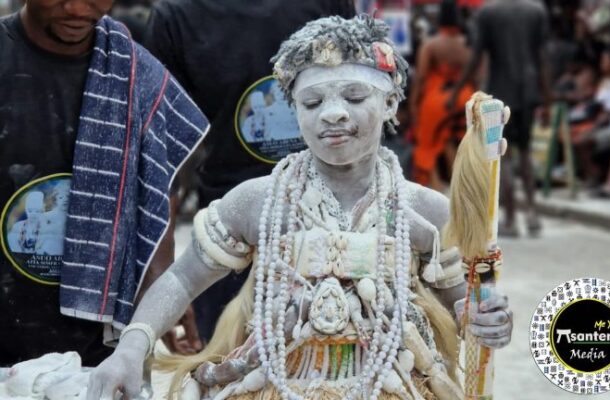By Nana Yaw Prekoh
Copyright ghanaguardian

The Ashanti Kingdom has been plunged into deep mourning as traditional priests and priestesses joined thousands of Ghanaians and international dignitaries at the Manhyia Palace to pay their last respects to the late Asantehemaa, Nana Konadu Yiadom III.
The funeral rites, which began on Monday, September 15, 2025, mark the start of four days of elaborate cultural and traditional observance for the revered Queenmother, who passed away two months ago.
The ceremonies turned Kumasi, the Ashanti regional capital, into the epicentre of national and cultural attention.
For centuries, before the advent of colonial imperialism, traditional priests and priestesses—locally called akomfoɔ—have served as the spiritual link between the Ashanti people and their gods.
They were central to healing, guiding communities during calamities, and preserving sacred traditions.
Their active participation in the ongoing funeral underscores their continuing importance in Asante society.
During the first day of the rites, groups of priests and priestesses clad in ritual garments performed libations and spiritual dirges, symbolizing both a farewell to the departed Queenmother and a reaffirmation of the Ashanti people’s connection to their ancestral roots.
Their presence added deep spiritual significance to a ceremony already steeped in tradition.
The Legacy
Nana Konadu Yiadom III was not only the sister of Asantehene Otumfuo Osei Tutu II but also a formidable leader in her own right.
Installed in 2017, she became the custodian of Ashanti royal lineage, guiding the palace on matters of succession, customs, and female leadership in Asanteman.
Her reign reinforced the Queenmother’s central role as both mother and advisor to the throne.
Her passing has therefore been described by many cultural historians as “the end of an era,” given the pivotal role she played in ensuring continuity and preserving the dignity of Ashanti tradition.
Dignitaries Pay Homage
At the Manhyia Palace, Otumfuo Osei Tutu II, flanked by the Kumasi Traditional Council (Nananom), received a long line of mourners.
Former President John Agyekum Kufuor, businessman and philanthropist Dr. Kwaku Oteng, the Ashanti Regional Police Commander, DCOP Emmanuel Teye Cudjoe, and the Mayor of Kumasi, Richard Ofori Agyeman, were among the high-profile personalities who paid homage.
Beyond individuals, institutions such as Kwame Nkrumah University of Science and Technology (KNUST), the Volta River Authority, SIC Insurance Plc, Total Energies, the Ghana Education Service (GES), and fraternal organizations like the Knights and Ladies of Marshall and Freemasonry also joined in the mourning, highlighting her wide influence across Ghanaian society.
Kumasi Becomes Centre of Mourning
The Manhyia Palace has been transformed into a cultural and spiritual hub with traditional drumming, the wailing of dirges, and the rhythmic sounds of the fontomfrom drums.
Thousands of mourners, including ordinary citizens, have filled the palace grounds and surrounding streets, creating an atmosphere of reverence, reflection, and pride in Ashanti heritage.
Security has been heightened across Kumasi as the influx of mourners continues to grow, with authorities expecting record crowds before the funeral concludes.
Closing Rites
The funeral rites will climax on Thursday, September 18, with final traditional performances, sacrifices, and rituals symbolizing the transition of the Asantehemaa’s spirit into the ancestral world.
The elaborate observances reaffirm the Queenmother’s central place in the Ashanti Kingdom—not merely as a figure of royal authority but also as a cultural icon whose influence extended beyond the palace into the heart of the identity.



